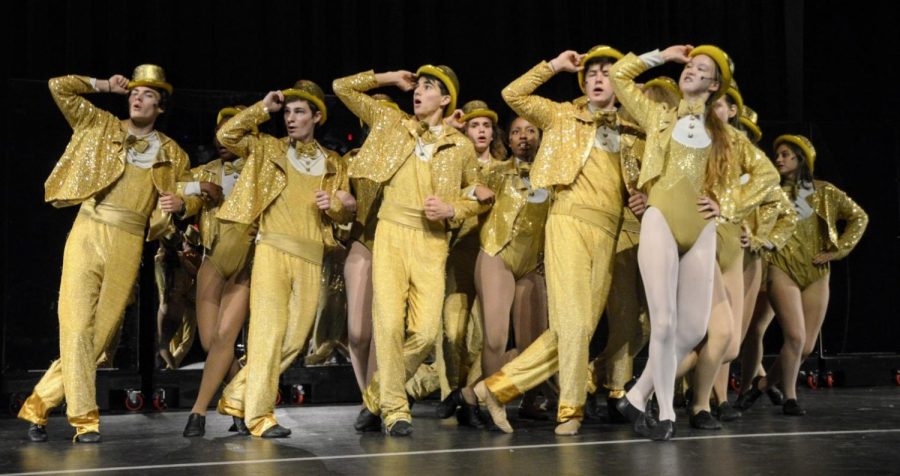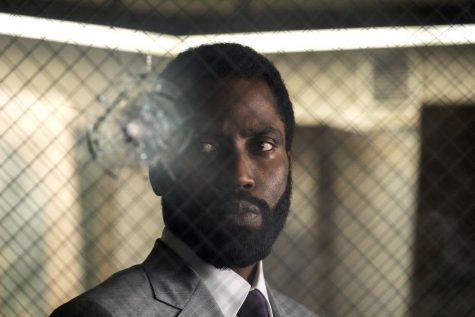From start to finish, fall Musical “A Chorus Line” stays en pointe
The original 17 members perform their final number, “One” in shiny gold costumes.
“A Chorus Line” brought many members of the Grady community to the auditorium last Thursday night to watch the 45 cast members sing and dance – the biggest opening night for any play held at Grady. At $8 a ticket for Grady students, and $12 for parents and friends, the expectations were high, and the cast and crew continually entertained.
The two-hour show follows the backgrounds of the typically unrecognized members of Broadway chorus dancers. The show’s director, Zach (Harrison Briggs) chose 17 out of 45 dancers to present themselves to him. Eventually dwindling down to only eight remaining dancers, and each character had a unique story to share.
Zach used each dancer’s headshot to select them to talk about themselves. This provided a more personal feel to both the audience members and the actors. The show used minimal props, which proved appropriate. Near the back of the stage, mirrors were turned to face the audience once a significant performance started, mimicking a typical dance room. The mirrors allowed the audience to see dancers reflect on themselves, both metaphorically and physically.
Along with the props, costumes were also simple. Dancers wore the basics, a simple leotard or even just jeans and a sweatshirt. However, each costume seemed fitting and natural to the character, as well as the environment of the show. The lack of flamboyant props made it easier for audience members to relate and connect with the cast. The finale performance included a spectacular scene, where the dancers performed a synchronized number complete with a kick line. They dressed in all gold outfits, which was very appropriate for the flashy finale.
The actors embodied their characters well. From dancing to singing, every actor on stage perfectly fit their role. The choreography was intentional. While not all the dancing was uniform, it still fits nicely. Members of both the ensemble and the main cast performed synchronized ballet. Mike Costa (Alex Tischer) gave an especially impressive tap dancing performance.

Freshman Nicholas Palmeros (right), sophomore Lucy Strohl, and junior Maddie Thorpe (left) watch as senior Alex Tischer performs his monologue.
There was lots of movement from comedy to a more serious tone, an element that reflects the culture of real life. Bobby Mills (Robert Mobley), Paul San Marco (Nathaniel Ward), and Judy Turner (Sienna Joseph) all gave versatile performances that both saddened and uplifted the audience with the shift between their raw vulnerability and easy humor.
There are many memorable, entertaining numbers, including “Dance: Ten; Looks: Three” and “I Hope I Get It”. “Goodbye Twelve, Goodbye Thirteen, Hello Love” was one of the most catchy numbers. The dancers reflected on their pubescent eras, tapping into the most uncomfortable topics that accompany growing up.
Throughout the show, Zach challenged members of the potential chorus line to open up about themselves. As the show developed, the characters developed too. They became more self-confident and open, sharing some of their most shameful, scary, and comedic experiences. The sensitivity that the actors emulate provided insight into the reality of unsatisfied dancers hoping to make it big on Broadway – the “unsung heroes”.
Overall, “A Chorus Line” provided the perfect combination comedy, drama, and tragedy. The simplicity of the costumes and set allowed a personal experience for audience members. All of the actors were portrayed their characters naturally and brought their experiences to life.

Ellie is happy to be a photographer for the Southerner. Besides that and writing for Nexus, she enjoys music, and is a member of the Grady Mock Trial team.











Nicholas Palmeros • Nov 30, 2018 at 3:39 pm
It was very fun, but a lot of work for 3 preformances